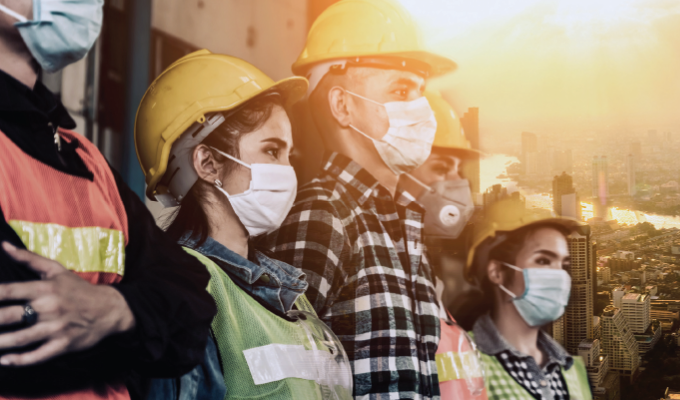By Matthew Hudelson
Nearly every industry has adapted in some way to the restrictions or changes caused by the COVID-19 pandemic. The construction industry responded swiftly by creating safer and smarter ways to build homes and office buildings. Many companies upgraded their field safety operations and adapted a health-first approach to their company core values and branding. As a result, the construction site is becoming safer every day. The COVID-19 pandemic protocols are a challenge since total prefabrication under controlled conditions is a long day coming. Everyone is looking to improve as designers, contractors, and owners seek visibility, efficiency, and sustainability in a constantly shifting landscape.
BIM technology is helping construction projects create and manage high-quality construction documents at speed. With less people working in close proximity, a Common Data Environment (CDE) is even more valuable. Firms that deploy BigData, BigBIM, and BigAI in design and pre-construction gain tremendous advantages. They can plan projects faster and create a tighter schedule so that the right resources and materials arrive on site at the right time.
As we look forward to a new year, many of the lessons learned in 2020 will set the construction industry up for success in 2021.
COVID IMPACT ON 2020
At the height of the initial COVID shutdowns in March and April, many jobsites completely stopped. According to a survey of construction firms by the Associated General Contractors of America, more than half of firms surveyed had projects stopped. As a result, 74 percent sought out Paycheck Protection Program loans to keep their staff. Unfortunately, not everyone was lucky enough to receive PPP money—nearly 40 percent of firms had to lay off employees due to the pandemic shutdowns.
When worksites reopened, the consensus was that a maximum of 60 percent of workers could return under strict social distancing rules. Tighter staffing restrictions created to control the spread of coronavirus will only exacerbate the current labor problem in the building sector in 2021.
HOW TO PREPARE FOR 2021
Unfortunately, COVID isn’t going anywhere anytime soon. 2021 will bring many of the same safety restrictions and social distancing rules that were created in 2020. But construction teams should take some important steps now to prepare for 2021.
Contract Automation. With virtual work becoming the norm, automating the contract process is key for surviving 2021. “Smart contracts’’ are efficient tools that the construction industry has yet to fully embrace. These electronic agreements integrate with the execution of the terms and conditions of contracts. They enable the automatic enforcement or execution of certain terms/provisions upon the happening of a condition precedent or predetermined event. A smart contract is a “self-executing” software that can be integrated with BIM and AI at various project stages—since, a contract is really a collection of “if X occurs, then Y happens” logic. As previously agreed upon conditions occur, the smart contract automatically begins executing the terms of the contract.
Intelligent Construction Drawings (ICDs)™. Advances in construction have offered solutions like augmented reality and 3D building but, despite more jobsite technology available now than ever before, working with construction drawings has remained a manual and inconsistent process. Smart drawing technology like Inertia’s industry-first Intelligent Construction Drawings (ICD)™ leverages the power of BIM in a brand-new way to allow construction teams a Common Data Environment (CDE). It’s a powerful way to access and manage information from a single source throughout the construction process. This new technology analyzes construction documentation and data to produce object-linked smart construction sheets, allowing users to assign records to items, rather than areas. By creating these smart objects, construction sheets are delivered to the field without the need for 3D modeling, enabling construction teams to implement smarter, faster decision making.
Intelligent Construction Drawings that integrate with BIM and AI is a critical step in the industry-wide shift to increase collaboration, negate risk, and empower a safety-first workforce. With these data-driven drawings, everyone on a project can leverage the data within the BIM model, in an interactive, construction sheet—all tied together through an object-based location map. The manual process of creating construction drawings is a near-constant pain point for every construction team, and ICD can solve this.
BIM is being used to deliver progress reports in real-world, real-time context to any mobile device. Model-based simulation, take-offs, scheduling, estimating, inspection, and progress tracking also drive significant value in workflows and personnel management. AI speeds through design algorithms to predict the massing, layouts, and workflows that best respond to the physical and environmental conditions of the site. This level of prediction and automation leads to pre-fabrication and installation of building components in the cleanest, safest conditions possible.
CLOSING THOUGHT
The health and safety of the teams working on construction sites has always been, and will remain, critical in 2021. As COVID-19 continues to impact the industry, project sites use exercise and other health management systems to encourage communication and behaviors that build trust. Many aspects of 2020 will remain habit in 2021—the handwashing, the social distancing, the increased work being done offsite. With more people working remotely, it’s more important than ever that construction crews, owners, and architects adopt BIM and ICD technologies to not only streamline the construction process, but also keep crews employed and guide the industry through the next uncertain year.
About the author:
Matthew Hudelson is the founder and CEO of Inertia Systems. Since 2010, Matthew has worked alongside builders, owners, inspectors, and design teams to learn and solve the challenges they face on complex construction projects with technology. Today, the Inertia Platform is used by leading general contractors, owners, and jurisdictions. For more, visit www.inertiasystems.com.
Modern Contractor Solutions, January 2021
Did you enjoy this article?
Subscribe to the FREE Digital Edition of Modern Contractor Solutions magazine.



